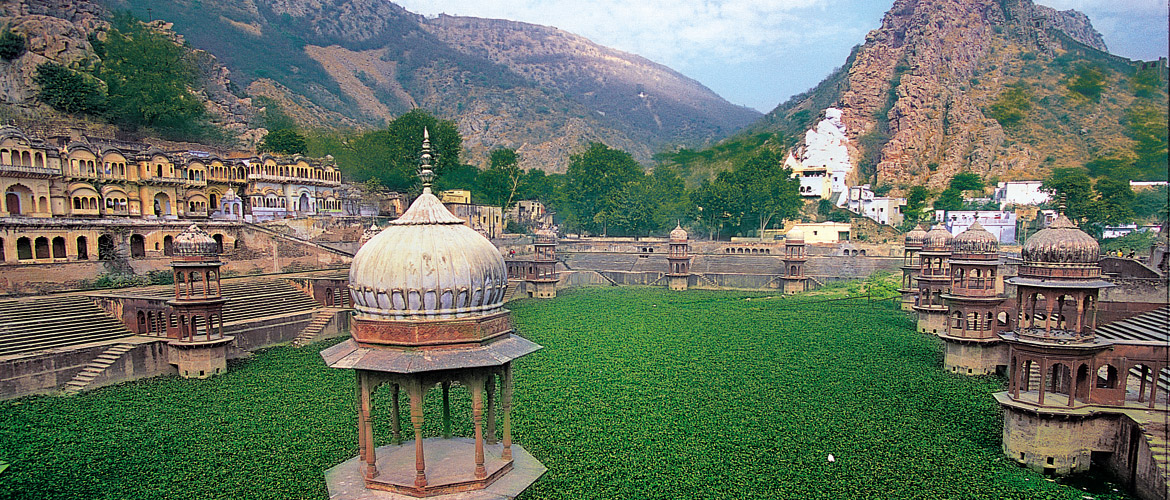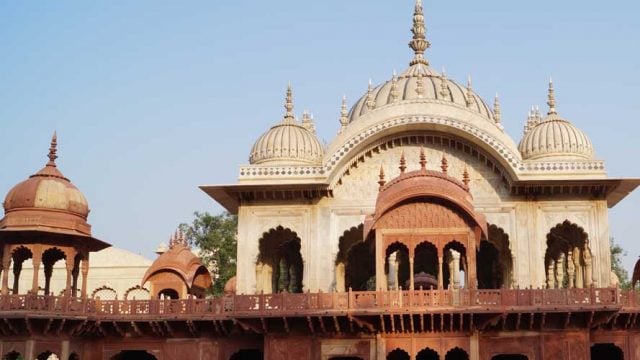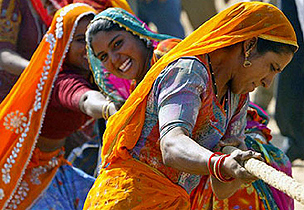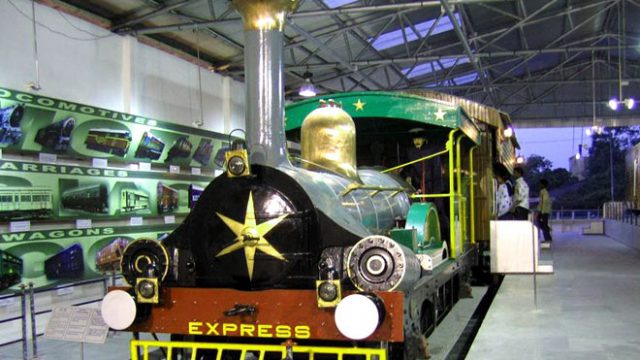A quaint case of Modern-India-meets-Mahabharata-era-meets-severely-British-nomenclature took place in 1948, just after India’s independence, when the kingdoms of
The ruler who first established Alwar, around 1720, was a Rajput, Pratap Singh, belonging to the clan of Jaipur’s rulers. He succeeded in taking an area called Macheri from the Mughals and set up his capital in Rajgarh, south of Alwar. By way of obtaining pardon for this usurpation, in 1774 his successor offered his services to Delhi against the Jats, and as a reward was recognised as an independent ruler. Separating himself completely from Jaipur, of which he appropriated several provinces, he established a permanent capital at Alwar.
Things to See & Do
The best time to visit Alwar is said to be between October and March, but my visit during the tail-end of the monsoons was quite an eye-opener. The area was a luminous green, and the town seemed surrounded by a continuous line of fortifications. Alwar can always be done in one day but the places around it deserve another day or two.

City Palace
The beautiful 18th-century City Palace is now the headquarters of the Collectorate. It was built by Maharaja Vinay Singh and blends Rajput and Mughal styles of architecture. The most interesting thing is that this building has no stairs, only gently inclining corridors that lead to the upper floors. Like most of the palaces in Rajasthan it contains a Sheesh Mahal (‘mirror palace’), an aggregation of rich decorations and mosaics. The City Palace Museum, also within the premises, is divided into three dusty, moth-ridden rooms. The first is a mixture of furniture, clothes and an enormous stuffed tiger. There’s a long dining table made of silver that is believed to have had water gurgling in silver channels down its length. The armoury room has table after table filled with weapons with murderous edges and points, their handles jewelled, carved and inlaid. The museum also has a fine collection of Mughal and Rajput paintings and ancient manuscripts. Entry fee Indians ₹5, foreigners ₹50; Timings 10 am-5 pm, Mondays closed.
Just behind the collectorate is a spectacular tomb of one of Shah Jahan’s ministers, called Fateh Singh ki Gumbad. Between the palace and the base of the mountains is a small pond, exaggeratedly called Sagar. Nearby, situated on a high terrace of pink sandstone, lies the impressive mausoleum of Raja Bakhtawar Singh and his mistress. Today it is known only by her name, as Moosi Maharani Ki Chhatri, for she made the leap from mistress to titled maharani by stepping into Bakhtawar Singh’s funeral pyre.
Bala Qila
The fort was built by the city’s oldest inhabitants, the Nikumbha Rajputs, and played host to Babur and Jahangir. Maharaja Pratap Singh annexed it in 1775. Known for its grandeur, Bala Qila, whose ramparts extend 5 km north to south and 1.6 km east to west, is perched atop a steep cliff at a height of 1,000 ft. It is a forbidding structure with 15 large and 51 small towers and 446 openings for musketry. But little remains of the structures inside the fort, except the Durbar Hall where the police have set up a wireless system, which surely can’t do any good to the paintings on the walls. Inside the baradari, still somewhat intact, are some exquisite frescoes. Permission has to be taken from the Superintendent of Police to visit the fort. His office is in the City Palace complex (Tel: 0144-2337453). Entry Free.
Purjan Vihar
A picturesque garden in the centre of the town, laid out in 1868, this garden has an enchanting setting. A level of this garden, built by Maharaja Mangal Singh in 1885, is called ‘Shimla’, because it always has a cooler-thanprevalent temperature. A marvelous cenotaph with an unusual Bengali roof, somehow also known as Moosi Maharani ki Chhatri, is situated here. Entry Free. Summer house is closed to tourists.
Moti Doongri
Moti Doongri, or Lansdowne Palace, is situated on an isolated rock on the town’s outskirts. It was built in 1882 at an estimated cost of over four-and-a-half million rupees. It was the main residence of the Maharaja of Alwar until 1928. Maharaja Jai Singh dismantled it with the idea of building a better palace at the site, and he sent for raw materials from all over Europe. But the ship bringing in this cargo sank. Now the palace compounds, with high walls all around, remain barren.
Vijai Mandir Palace
A splendid palace built by Maharaja Jai Singh in 1918, Vijai Mandir overlooks a beautiful lake. A fabulous Ram and Sita Temple here used to attract a number of devotees, especially during Ram Navami. The palace is closed due to family disputes. A few bumpy kilometres off the main Alwar-Sariska Road is the beautiful Jai Samand Lake constructed by Maharaja Jai Singh in 1910. It is a popular picnic spot and a great place to watch the sunset.
The Last Notes
In Alwar, you can also hear an unusual one-string instrument called bhapung. Interestingly, traditionally all bhapung players, though born Muslim, are also devotees of Shiva because they believe the instrument derives from Shiva’s dumroo. If you are in Alwar, try calling the local bhapung group (Tel: 2372168). They also give private performances for a fee.
Where to Stay & Eat
Neemrana-run Hill Fort Kesroli (Tel: 01468-289352, Mob: 0982981765; Tariff: ₹2,500-6,750) is said to be the “oldest heritage site in India where you can stay”. About 7 km from Alwar is Hotel Burja Haveli (Tel: 0144-5131288, 2888140; Tariff: ₹2,400-3,200), a 240- year-old haveli with a pool. The Circuit House (Tel: 2700650; Tariff: ₹750) is another heritage option; you need the DM’s permission to stay (Tel: 2337565). Hotel Aravali (Tel: 2332883/ 316; Tariff: ₹700-4,200) is by far the best bet in Alwar. Hotel Alwar (Tel: 2700012, Tariff: ₹2,000-3,500) has spacious rooms and is within a few minutes of most monuments. RTDC’s Hotel Meenal (Tel: 2347352; Tariff: ₹1,000- 1,300), close to the Circuit House, lies a little out of town but it is a safe bet. If you have a sweet tooth, don’t miss the Alwar mawa. For a more regular meal, the gatte ki sabzi and desi ghee ki missi roti at Prem Pavitra Bhojnalaya near the old bus stand are superb. At Ghanta Ghar, Baba Hotel makes paranthas and inexpensive veg thalis. Also try Hotel Inderlok Classic, a veg restaurant at Company Bagh Road. Pick up Alwar’s famous milk cake, kalakand.
AROUND ALWAR
Silserh Lake (13km)
In 1845, Raja Vinay Singh built a small white palace for his queen, Shila, in a dramatic location overlooking the Siliserh lake. Today it is a heritage hotel (Hotel Lake Palace, Tel: 0144-2886322; Tariff: ₹2,000-4,000) run by the RTDC — an idyllic picnic spot with an enchanting landscape. Sariska and Pandu Pol (31 km)
Sariska and Pandu Pol (13km)
Commissioned by Maharaja Jai Singh, Sariska Palace was once extremely grand, boasting of a ‘French’ pavilion and a pool. Wide gardens with fountains make its isolation even more stunning. But all this is now in ruins situated in the middle of tiger territory, though antelopes and birds are easier to spot in this sanctuary. The big cats used to be so numerous that Maharaja Jai Singh and his guests could shoot tigers and leopards from the palace balcony! These forests are also supposed to have sheltered the exiled Pandavas. A picturesque spring emerges from the rocks near Pandu Pol and there is a temple dedicated to Hanuman. If your motive is not the temple but only wildlife, don’t visit on Tuesdays or Saturdays as the crowds are huge
Sariska NP entry fee Indians Rs 60, foreigners ₹400, Vehicle ₹160, Cameras Video ₹250, Timings 6-10am, 3-6 pm.
Once the hunting lodge of the royal family of Alwar, The Sariska Palace (Tel: 0144-2841322-23/ 25; Tariff: ₹8,400-19,500) is now a heritage hotel with modern amenities. Tiger’s Den Hotel (Tel: 2841342/ 44; Tariff: ₹2,000-4,000) is an RTDC property situated at the gate of the sanctuary. Advance booking is crucial.
Name It is said the Salwa tribe gave the name ‘Salwapur’ to the region, which became Salwar and then Alwar
Age It was part of the Matsya Desh Kingdom according to the Mahabharata, but modern Alwar began as a capital of the Macheri Kingdom that was recognised in 1774
State Rajasthan
Location In the north-eastern Mewat region of Rajasthan, not far south of Delhi
Distances 142 km NE of Jaipur, 164 km SW of Delhi
Route from Jaipur NH8 to Shahpura via Amer; SH to Alwar via Bairat, Thana Gazi and Sariska
Route from Delhi NH8 to Dharuhera via Gurgaon; NH71B to Bhiwadi; Bhiwadi-Alwar Toll Road to Alwar
heritage
Quick Guides
Rajasthan





